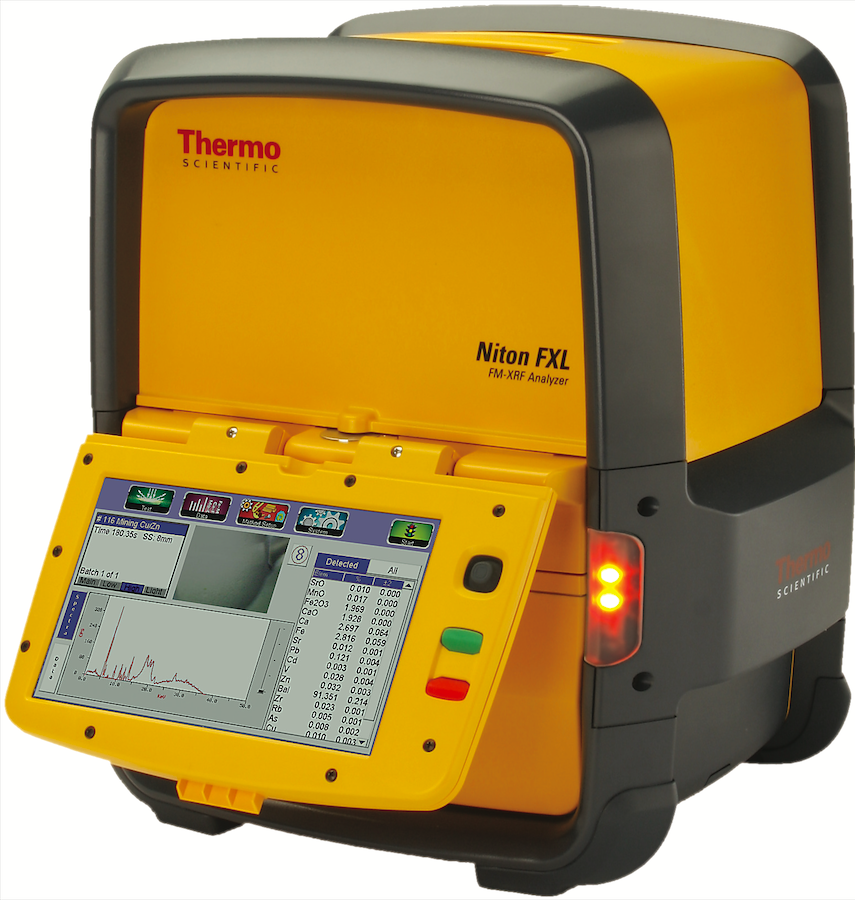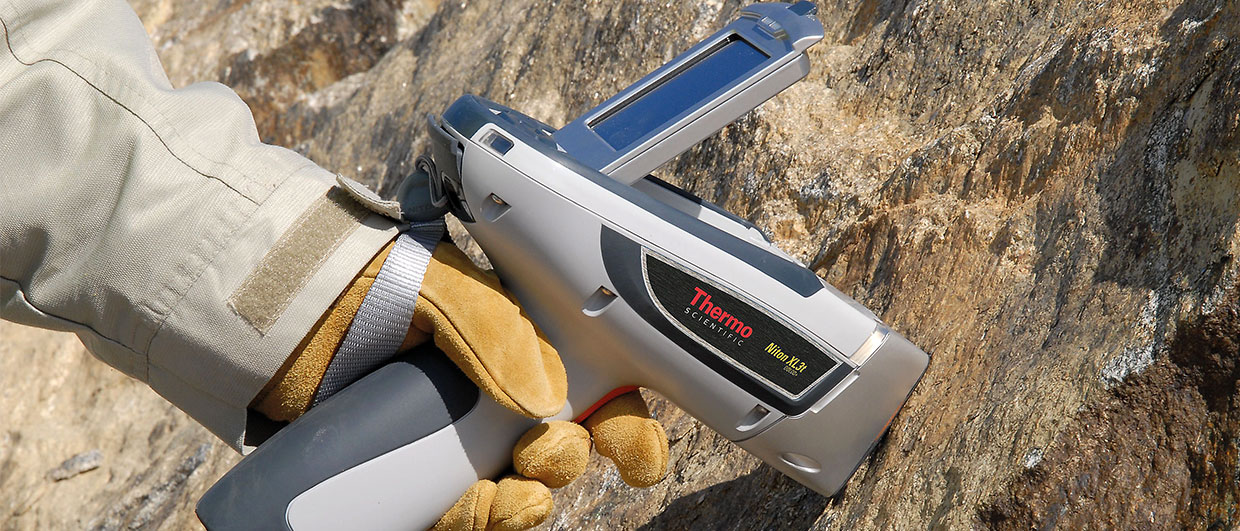Field-portable x-ray fluorescence (FPXRF) is a technique that is gaining momentum and acceptance in addressing applications in various fields in geology and mining. Thousands of these instruments are currently used in exploration and mining projects around the world. Now, for the first time, oil and gas companies are starting to benefit from the unique fast analysis capability that FPXRF offers.
What is Field Portable XRF?
XRF is a surface analysis technique in which a sample is bombarded with high-energy primary x-rays or gammas. This causes the sample to emit characteristic ‘secondary’ (or fluorescent) x-rays, which are detected and plotted based on energy and intensity. The energy of a detected secondary x-ray is unique for each element, and the corresponding intensities are converted to concentrations and reported as percentages (%) or parts per million (ppm). XRF is a mature and dependable technology, and FPXRF devices host this capability in a small handheld 1.5 kg pistol package.

This type of instrument has a number of salient features. As well as being light and portable, it is safe and user-friendly, with geologists and technicians requiring only a few hours training. It can analyse any type of geological sample, from cores to cliff faces, in realtime on-site, taking between 30 seconds and a few minutes depending on the accuracy and precision requirements. Up to 25 elements can be measured simultaneously from uranium (U) to magnesium (Mg), including the light elements such as aluminium (Al), phosphorus (P), silicon (Si) and sulphur (S). Calibration factors can be adjusted by users to match their specific sample matrix type, with some instruments able to do this task internally by built-in type standardisation.
The handheld device uses a Li-ion battery, which lasts about eight hours, and a few models have built-in GPS, which records the coordinates for each sample that is analysed. Some of these devices can also be paired with external GPS/GIS devices in order to make geochemical maps in real time.
FPXRF in Oil and Gas E&P
FPXRF can analyse a variety of sample types which are common in the oil and gas upstream exploration and production industry, including drill cuttings, oil and gas cores, outcrops, and piston-cored sediments. The geochemical data from these analyses can easily be used in mud logging for the identification of oil and gas formations, as well as in chemostratigraphy and geosteering.
Although FPXRF cannot analyse hydrocarbons, they can be used to characterise reservoir properties that influence porosity (cements), permeability (clays, cement type), fracture population (Si content), and productivity (e.g. Si, Mg content). FPXRF is used on-site to determine elemental composition of a sample in real time and then the mineralogy of the sample can be inferred from its chemical composition. The mineralogy is subsequently used to infer physical properties of the rock unit. Such application in oil and gas E&P can be shown as:
Elemental composition → Mineralogy → Physical properties of host rock → Process decisions in the field
Bulk chemistry is used to infer sample mineralogy and thus identify silicates, alumino-silicates (e.g. clay and feldspar), carbonates, and sulfides. For example, a lower Si/Al ratio indicates greater alumino-silicate content in a rock unit because these minerals have high Al content.

Elemental diagrams can also be used to infer mineralogy. The Fe-S diagram (above) shows that, in this example, the host mineral for sulphur is pyrite (FeS2) rather than gypsum (CaSO4H2O). Si/Al is a basic indicator of the abundance of quartz (SiO2) versus alumino-silicates such as clays and feldspars. The combination of Si/Al and Ca/K ratios can show the relative amount of clay, quartz, and feldspar in the gas/oil formation. For example, high Ca/K indicates the presence of calcite (CaCO3) cement and high Si/Al shows increased quartz (SiO2) in the sandstone. Ca/Mg ratios can provide a quantitative determination of the dolomite content of the carbonate rock.
As light elements such as Al, Si and Mg are very important in lithological investigations, sample preparation might be necessary. Some companies (such as Thermo Fisher Scientific) offer field portable sample preparation tools which are specified for oil and gas exploration and mining.
A number of properties of the reservoir rock can be characterised using portable XRF, including productivity, which can be defined by analysing redox sensitive elements such as V, Cr, Ni, Mo, Mn and Fe to detect oxic/anoxic boundary in rocks. These and other trace elements can also be used for chemo-stratigraphic correlations. Aluminium content can be used as an indicator of clays in the rock ground mass and thus permeability, while Si content can be an indicator of fracture population and fracture potential. Porosity and cement type can also be identified using portable XRF.
Fast and Reliable Data
In conclusion, FPXRF analysers can provide fast and reliable geochemical data at the drill site, in the field, and in the core lab. This allows geologists to predict where the oil and gas is in the rock formation and what factors affect the porosity, and to predict the volume of oil and gas present. It also allows them to determine how the permeability of the rock can affect the flow of oil and gas from the rock to the well bore, and how a rock formation can be engineered to produce more by fracturing and well treatments. This can help operators to maximise the potential of each well and avoid waste related to ineffective fracture treatments.
About the Author
Alireza Somarin has a PhD from the University of New England, Australia, and was a post-doc at Lakehead University, Canada. He has taught various geology courses in several countries, including Canada, for more than 13 years and has published over 70 articles, including books, journal/conference papers, research reports, and short course volumes. He is an experienced geologist in the field of portable XRF and its application in metal exploration/mining as well as oil and gas exploration and production.





